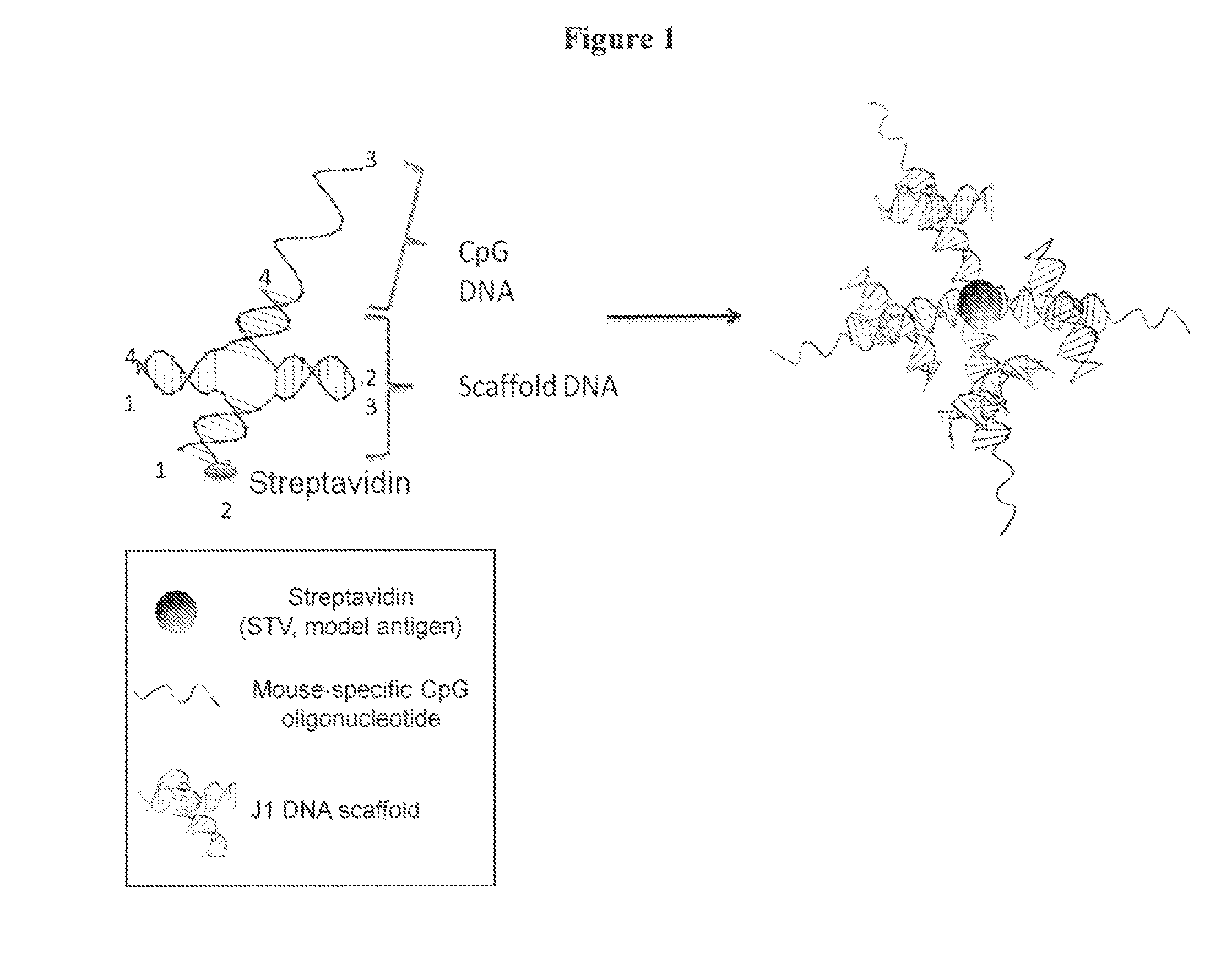Novel dna-origami nanovaccines
a technology of nanovaccines and dna-origami, which is applied in the field of new dna-origami nanovaccines, can solve the problems of ineffectiveness, safety issues or inability to reach the current vaccine development strategy,
- Summary
- Abstract
- Description
- Claims
- Application Information
AI Technical Summary
Benefits of technology
Problems solved by technology
Method used
Image
Examples
example 1
[0162]Safe and effective vaccines offer the best health intervention in disease control. However, current strategies for vaccine development suffer from either safety or ineffective issues. Accordingly, DNA nanostructures as scaffolds to assemble various antigenic components have been explored and are described herein. A proof-of-concept immunogenicity test was conducted by assembling a model antigen (streptavidin) and immunoadjuvant CpG oligonucleotide onto a DNA-branch nanostructure (FIG. 1). A schematic illustrating an immune response cascade elicited by this assembly is depicted in FIG. 2. Antibody responses against the DNA nanostructure antigen were evaluated in mice, as shown in FIG. 3. The antigen engineered onto the DNA-scaffolds elicited stronger memory antibody responses than the one induced by the same antigen in the conventional way. Additionally, conjugated CpG (CpG-J1+PE-STV) showed higher cellular uptake in vivo as compared to free CpG (free CpG+PE-STV) (FIG. 4). As s...
example 2
Novel HIV-Vaccines Built on DNA-Nanoparticles
[0164]The feasibility of using DNA-nanotechnology to rationally design and create more effective prophylactic HW vaccine candidates is described herein. Additionally, this novel approach may be extended, for example, to the vaccine development against other infectious agents, tumors and even addictive substances.
[0165]The modest success of the recent Thai RV-144 clinical trial, which only offered 31% protection from HW transmission among high risk groups, highlights an urgent need for new strategies in designing HW vaccines. Given the general consensus on the generation of neutralizing antibodies as an important correlate for protective immunity against HIV, some recent effort has been directed toward identifying neutralizing epitopes and displaying these epitopes onto a protein scaffold. This approach led to the production of antibodies resembling some aspects of neutralizing antibodies, but has still failed to neutralize HIV, indicating...
example 3
Assembly of Systems-Biology Selected Epitopes onto Controllable DNA-Origami
[0170]Substance abuse is known to contribute to the transmission of human immunodeficiency virus type 1 (HIV-1) among adolescents and young adults. While a high HIV prevalence among IV-drug users is caused by direct exposure to HIV-contaminated blood through needle sharing, many drug users, including those using non-injecting substances, may also acquire HIV through risky sexual behaviors influenced by illicit drugs. Despite some success of several HIV prevention programs, such as clean needle exchange and safe-sex education, and powerful anti-retroviral drugs in reducing HIV transmission, an HIV vaccine may ultimately be our best hope for eradicating HIV / AIDS in high-risk drug user populations. Given the extremely high mutation rate of HIV genomes, only the prophylactic HIV vaccines that can induce immunity at the portal of entry would be considered valuable in controlling HW infection. Despite three decades...
PUM
| Property | Measurement | Unit |
|---|---|---|
| Composition | aaaaa | aaaaa |
| Immunostimulation | aaaaa | aaaaa |
| Immunogenicity | aaaaa | aaaaa |
Abstract
Description
Claims
Application Information
 Login to View More
Login to View More - R&D
- Intellectual Property
- Life Sciences
- Materials
- Tech Scout
- Unparalleled Data Quality
- Higher Quality Content
- 60% Fewer Hallucinations
Browse by: Latest US Patents, China's latest patents, Technical Efficacy Thesaurus, Application Domain, Technology Topic, Popular Technical Reports.
© 2025 PatSnap. All rights reserved.Legal|Privacy policy|Modern Slavery Act Transparency Statement|Sitemap|About US| Contact US: help@patsnap.com



